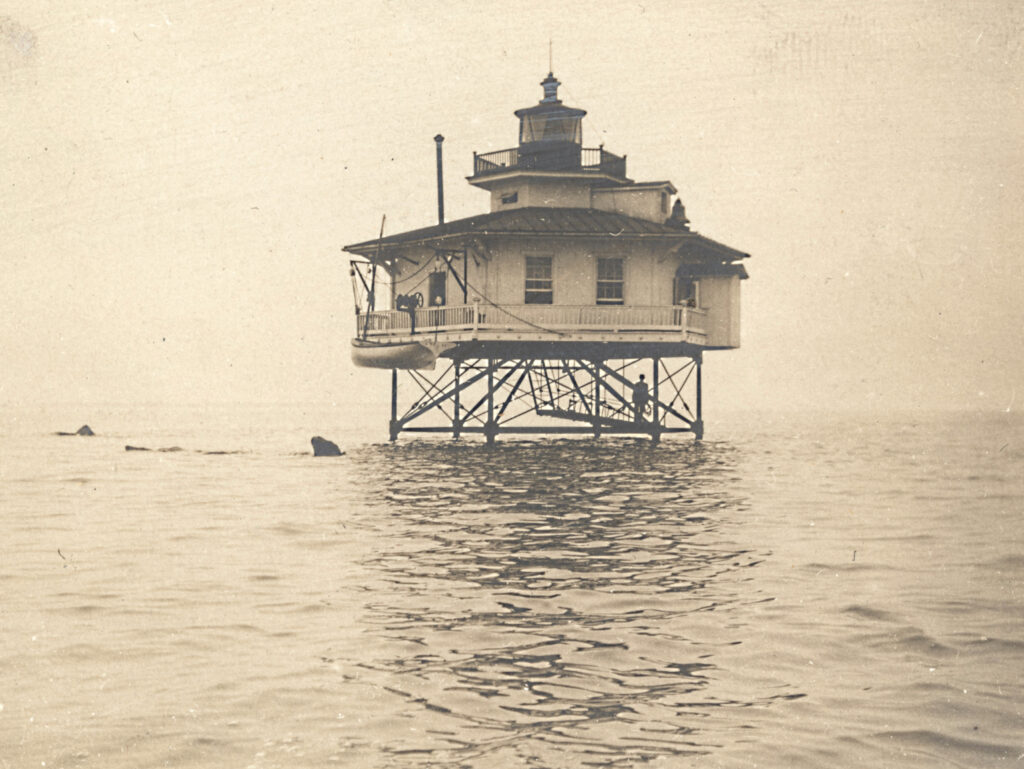
Note the single dormer by the fog bell.
(National Archives)
Although the majority of screwpile cottages were square, a significant number were not. A hexagonal design was common from the beginning and was used for at least 34 lighthouses. It seems the hexagonal lights usually had a fog bell, so presumably the shape was intended to provide additional space for that reason. The last two built were Pages Rock, Virginia, in 1893 and Ragged Point, Maryland, in 1910. At least two octagonal screwpile cottages were also built, both in the Chesapeake: Greenbury Point Shoal and the second structure at Craney Island.

(National Archives)
Thomas Point Shoal is the only extant in-water screwpile cottage lighthouse that has not been moved. It was also the last one automated and probably the only one to have six dormers. The lighthouse was designated a National Historic Landmark in 1999.
The oldest surviving American screwpile cottage lighthouse is Seven Foot Knoll, now moved ashore in Baltimore as a museum. However, it has two major differences from all other screwpile cottage lighthouses: the dwelling is circular and made of iron, not wood.

Note the offset lantern.
(National Archives)
Besides the two prominent symmetrical versions – square and hexagonal – a small number of other designs were used. Two square screwpiles cottage had off-center lanterns: Killick Shoal, VA (1886) and Lake Borgne, LA (1889). Besides the lantern placement, the cottages also appear to have been slightly smaller than the other square lights. An off-center version with mansard roof was used at Long Beach Bar, New York, and Bridgeport Harbor, Connecticut. Both were established in 1871. These variants may have been experimental.
Despite the sheer number of screwpile cottages, very few survive and most of those have been moved ashore for preservation. These structures were vulnerable to ice flows, hurricanes, and fire. As local aids to navigation they sometimes became obsolete when new channels were created. Some were replaced by caisson lighthouses which were much more resistant to ice. Particularly in Chesapeake Bay, the Coast Guard removed many of the traditional lighthouse structures to repurpose their pilings for modern automated beacon lights.

(National Archives)
Researching screwpile cottages is more difficult than your average lighthouse. Not only are they nearly all gone, their size and locations meant they were rarely photographed or visited by tourists. For many of the early screwpile cottages no photos may have ever existed. Since they were mostly built using standardized designs, lighthouse-specific architectural drawings aren’t always available. Some stations went through two or three different screwpile cottages and it’s not always clear which design was used with each iteration of the lighthouse.
I have attempted to compile as complete a list as possible of screwpile cottage lighthouses, grouped by design style and sorted by year established. Corrections and additions are always welcome.

Josh Liller is the Historian and Collections Manager for Jupiter Inlet Lighthouse & Museum. He also serves as a Historian for the Florida Lighthouse Association. He is co-author of the revised edition of Five Thousand Years On The Loxahatchee: A Pictorial History of Jupiter-Tequesta, Florida (2019) and editor of the second edition of The Florida Lighthouse Trail (2020).

